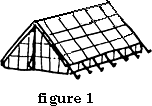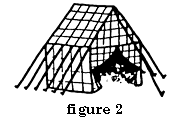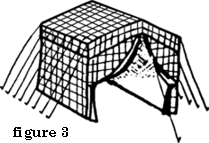Early Period Tents
by Lord Orvin af thaet hus Tate
First, this is not a "how-to", but rather a "what-can-be-done" article. You are now set: your early period personae is complete from your costume and jewelry to your feast-gear, your armor, mannerisms, etc. --and now you are going to use a 12th century arming pavilion? Not likely.
Besides the already well-known Viking one, there are other early period tents. Perhaps the most likely tent for the Celts or Germanics to have been exposed to is the Roman legionary tent. It would not have been too impossible for the neighbors of Romans to have obtained these tents --one way or another.
Three types of Roman army tents are pictured on Trajan's Column. They are the eight-man legionary tent (Fig.1), the officer's tent (Fig. 2) and the general's tent (Fig.3). it is assumed that the same types of tents were used by the imperial and republican armies of Rome.
The eight-man tent, the tent of the common foot soldier, was ten Roman feet square with two feet on each side for the guy ropes. It was spacious enough to hold eight men and their equipment (quite a kit indeed). In the Roman system of martial organizations such as squad is called a "contubernium". The tents were made of leather square stitched together to form the canopy.
Two types or tent pegs (Figs. 4 and 5) are known, these having been excavated at the Numantia, Spain siege site (both now in the Romish Germanishches Zentralmuseum, Mainz, West Germany). They were both made of iron. The eight-man and officer's tents used 14 pegs, while the general's tent used 20 pegs. It would appear that the largest of the tent pegs (Fig. 4) would not be larger than a foot and the smallest (Fig. 5) eight inches. Such pegs, if you do not have access to a forge, or local smithy to make some, could be reasonably made of wood (oak or walnut being best for durability and both are period materials).
Height for the tents was not given, but the eight-man tent appears (from the illustrations) to be approximately five to six feet high. The officer's tent looks to be twice as big as the legionary tent, and the general's tent a third larger than that. Tent poles were more than likely made of wood. Again, period wood, which is durable as well, is oak or walnut. For ease of transportation, it would not be unreasonable to make the poles sectional, much like the poles of present day Army pup tents (the Romans were known to have made equipment so that it could be divided among the solders of a legion, for carrying in the individual's kit). A modern day step to prevent rot would be to treat your poles and pegs with shellac or polyurethane, but for a more period flavor, use bee's wax. Although the Romans used leather, substitutes which are period, less heavy and expensive and more likely to survive the ravages of weather and storage can be used for the tent canopy. A tightly woven linen or wool would be period, but has to be treated for weather before use.
Water proofing materials can be found at hardware stores, a good one is *Thompson's Water Seal. Alternatively, non-period materials such as awning fabric (used in today's tents and awnings) can be used, but should be checked for water proofing.
*Ceara's note: Thompson's has changed their formula since the article was written, and isn't suitable for canvas anymore. I have used Armor All waterseal and have heard good things about Behr. Or you could just buy pre-treated canvas like Sunforger.
The only period rope material I know of is hemp.
There are many other types of early period tents. Nomadic desert culture, must have used tents similar to the modern Arabian herdsmen. The Huns probably had tents similar to those used by the present day Mongolian Tribesmen. Personally I have wanted to make a Viking longhouse from plywood, about the size of a pup tent...
Sources:
Connolly, Peter Greece and Rome at War. Macdonald Phoebus, Ltd.,1981.
Webster. Graham The Roman Imperial Army of the First and Second Centuries, A.D. Barnes, and Noble-Books, 1985.
Editor's Note: The tents of the upper level officer, were far from Spartan. Julius Caesar had a mosaic floor that was transported in sections from site to site and used as the floor for his tent.


Back to Early Period #5 |
Back to Early Period Index |
Back to PastTimes











